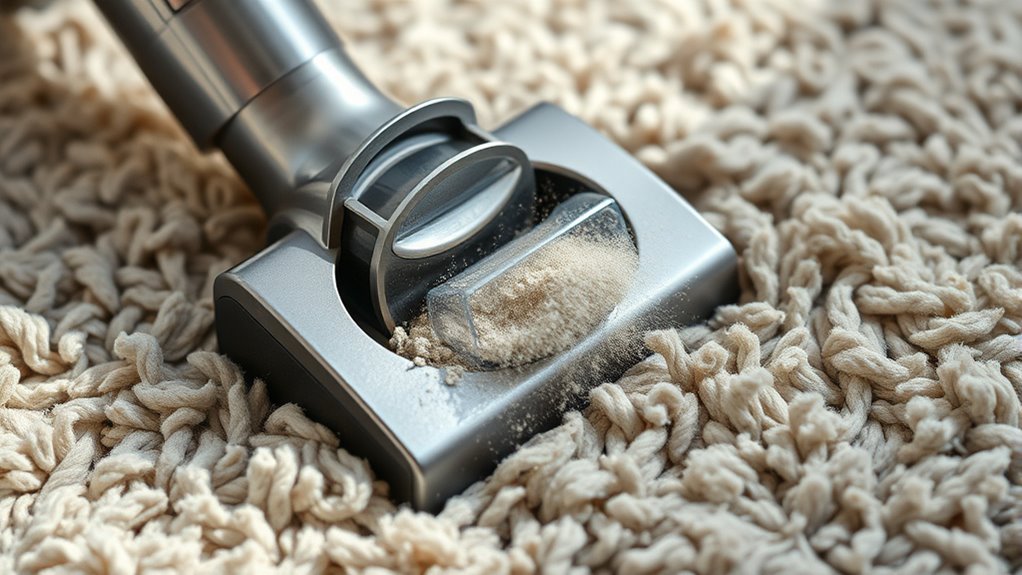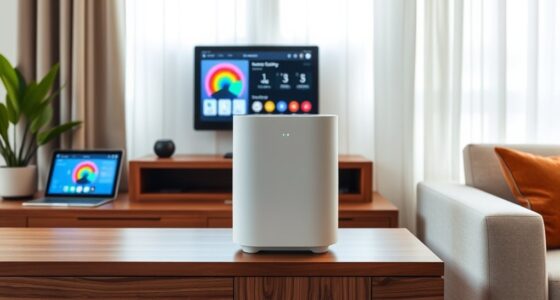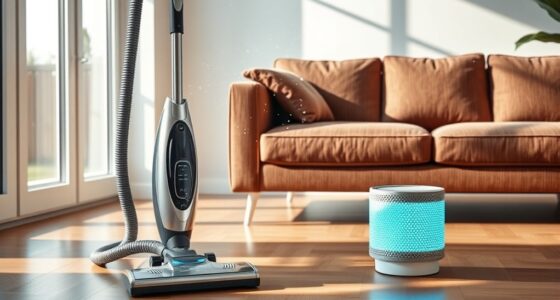CFM, or cubic feet per minute, measures how much air flows through your vacuum, impacting its ability to pick up dirt and debris effectively. A higher CFM usually means better airflow, helping to loosen and lift debris from various surfaces. However, it’s not the only factor—suction power and design also matter. To optimize your vacuum’s performance and understand what truly makes it effective, explore the details behind CFM and how it affects cleaning results.
Key Takeaways
- CFM (Cubic Feet per Minute) measures the volume of air a vacuum moves, indicating airflow capacity.
- Higher CFM generally improves dirt and debris pickup but doesn’t guarantee stronger suction.
- CFM impacts cleaning efficiency across different surfaces, especially deep carpet cleaning.
- It is different from suction force, which measures the vacuum’s ability to pull debris inward.
- Selecting a vacuum with appropriate CFM enhances performance, but overall design and filtration are also crucial.
Understanding the Basics of CFM in Vacuum Cleaners

To understand how well a vacuum cleaner cleans, you need to know about CFM, which stands for cubic feet per minute. CFM measures how much air the vacuum moves, directly impacting its cleaning ability. A higher CFM indicates more airflow, helping debris and dust loosen and lift from surfaces. When considering CFM, also pay attention to the vacuum filter, as a good filter guarantees efficient airflow without clogging. Additionally, the cord length plays a role in convenience, allowing you to cover more ground without switching outlets. A longer cord combined with a high CFM means fewer interruptions and better overall cleaning performance. Understanding these factors helps you choose a vacuum that’s powerful enough to handle your cleaning needs efficiently. Moreover, airflow quality significantly influences how effectively a vacuum can remove dirt, making it a crucial aspect of performance.
How CFM Influences Vacuum Performance and Cleaning Power
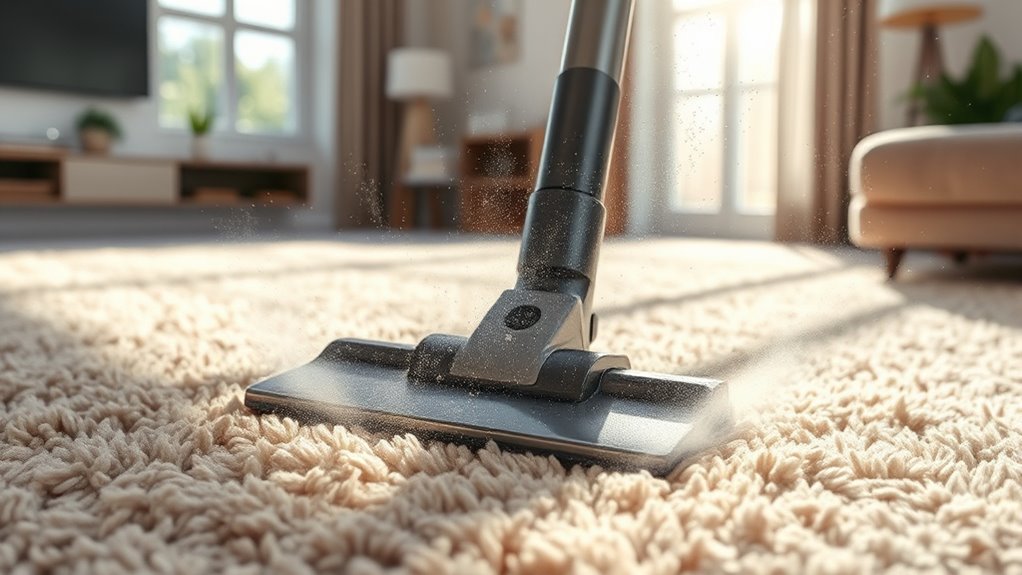
Ever wonder how the airflow in your vacuum affects its cleaning power? Higher CFM means more air passes through the system, boosting your vacuum’s ability to pick up dirt and debris efficiently. However, increased airflow can also lead to more airflow noise, which might make your cleaning sessions louder. It’s important to find a balance—too much airflow can strain the motor, reducing its durability over time. A well-designed vacuum manages airflow to maximize cleaning while minimizing noise and motor wear. When CFM is optimized, you get better cleaning performance without sacrificing the longevity of your vacuum. So, understanding how CFM influences airflow noise and motor durability helps you choose a machine that’s both powerful and long-lasting.
The Difference Between CFM and Suction Force
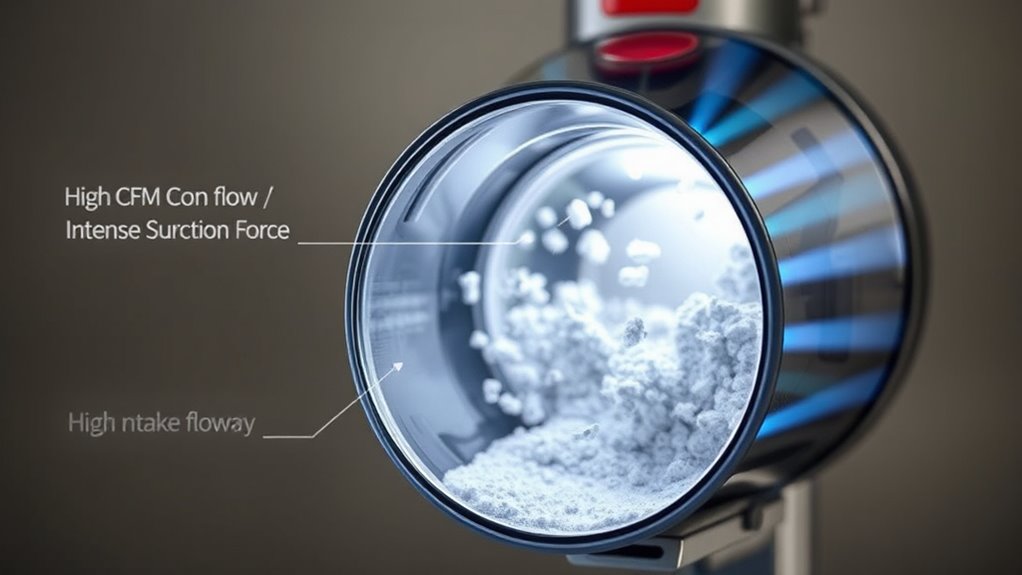
While both CFM and suction force are essential for vacuum performance, they measure different aspects of how a vacuum cleans. CFM, or cubic feet per minute, gauges airflow efficiency, showing how much air the vacuum moves. Suction force, on the other hand, measures the vacuum’s ability to pull in debris, reflecting its overall cleaning power. High CFM means better airflow, which helps loosen and lift dirt from surfaces, especially over large or uneven areas. Suction force is critical for picking up heavier debris and deep cleaning carpets. Understanding the difference helps you choose a vacuum that balances airflow efficiency and suction power for peak vacuum performance. Proper vacuum maintenance ensures both factors work together to ensure thorough cleaning and efficient operation.
Why Airflow Matters When Choosing a Vacuum

Airflow plays a crucial role in how effectively a vacuum cleans, as it directly influences how well debris is loosened and lifted from surfaces. A good airflow design ensures that dirt moves smoothly through the vacuum, maximizing cleaning power. When airflow is optimized, your vacuum can pick up more dirt with less effort. Filter efficiency also impacts airflow; high-quality filters maintain steady airflow while trapping fine particles. Poor filter design or clogging can reduce airflow, decreasing cleaning performance. When choosing a vacuum, look for models with strong airflow and efficient filters, which work together to improve overall cleaning. A well-designed airflow system ensures your vacuum performs at its best, making your cleaning routine quicker and more effective. Additionally, integrating advanced filtration technology can help maintain consistent airflow while trapping a broader range of airborne pollutants.
Common Myths About CFM in Floor Care Devices
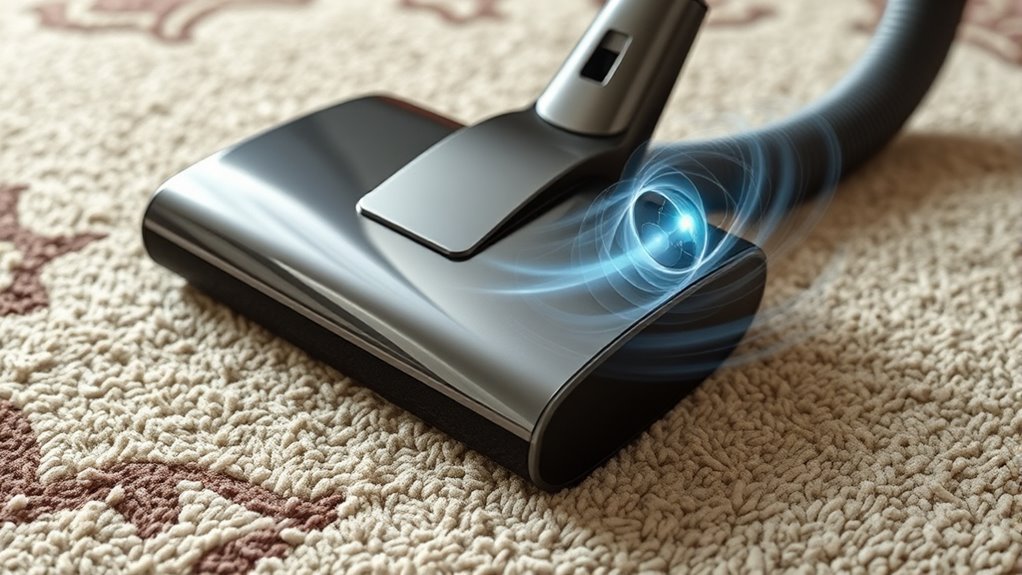
Many people assume that a higher CFM (cubic feet per minute) automatically means a more powerful vacuum, but this isn’t always true. This is a common airflow misconception. Myth debunking reveals that CFM alone doesn’t determine cleaning effectiveness. A vacuum with high CFM might push a lot of air but can still struggle to pick up debris if the suction power is weak or airflow isn’t properly directed. Conversely, a device with moderate CFM but good design can outperform one with higher airflow. It’s essential to understand that airflow is just one part of a larger system, including suction, filtration, and brush design. Additionally, sound vibrations are believed to enhance cellular regeneration and overall health, which can also play a role in the effectiveness of cleaning devices. Avoid falling for airflow misconceptions—focus on overall performance, not just CFM ratings.
How to Read and Compare CFM Ratings on Vacuum Models
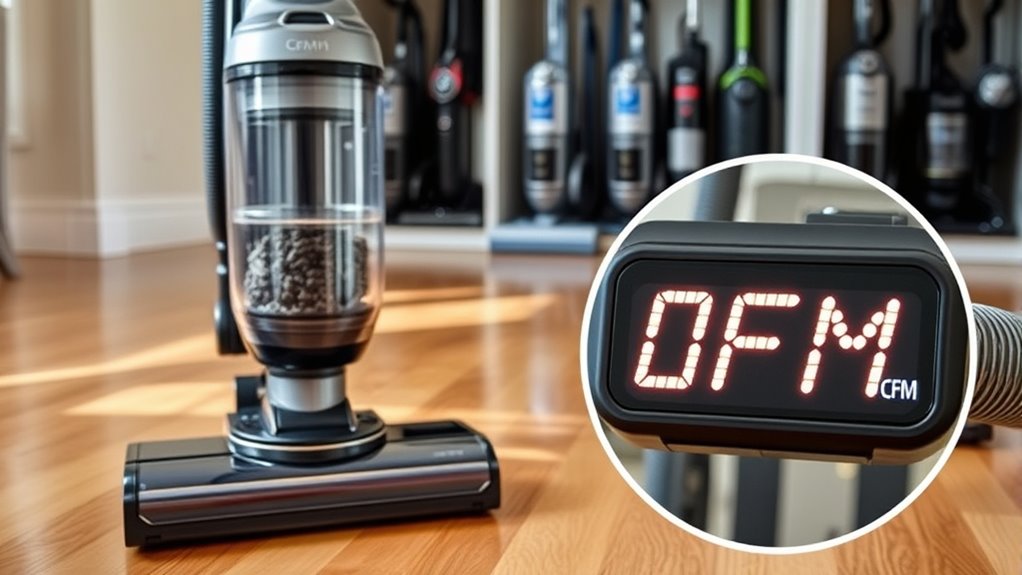
Understanding CFM values helps you see how powerful a vacuum really is. When you compare different models, it’s important to look at their CFM ratings and what those numbers mean. Learning how to interpret these ratings makes choosing the right vacuum easier and more informed. Additionally, knowing how Mazda Tuning can enhance vehicle performance provides insight into optimizing power and handling, similar to how understanding CFM can optimize your vacuum’s cleaning efficiency.
Understanding CFM Values
When comparing vacuum models, CFM, or cubic feet per minute, is a vital measurement that indicates how much air the vacuum can move in a minute. To understand CFM values, consider the airflow design, which influences how efficiently air is directed through the vacuum’s system. A well-designed airflow system maximizes CFM, helping you pick a model that cleans effectively. Motor efficiency also plays a pivotal role—more efficient motors typically produce higher CFM ratings without increasing energy consumption. Keep in mind that higher CFM doesn’t always mean better cleaning; it’s about how well the airflow design and motor work together. By understanding these factors, you can better interpret CFM ratings and select a vacuum suited to your cleaning needs. Recognizing airflow design is essential because it directly impacts how the vacuum performs in real-world situations, ensuring you make an informed purchase decision.
Comparing Different Models
To effectively compare vacuum models, you need to know how to read and interpret their CFM ratings. Higher CFM indicates better airflow, but other factors influence performance. Consider these key points:
- Airflow design: Look at how the vacuum directs airflow; efficient designs maximize CFM.
- Motor efficiency: A more efficient motor produces consistent airflow without wasting energy.
- CFM consistency: Check if CFM remains stable across different surfaces or if it drops.
- Model specifications: Compare CFM ratings alongside other features like filtration and attachments.
- Additionally, understanding Volkswagen Tuning concepts such as engine performance enhancements can provide insight into how airflow improvements impact overall efficiency and power.
Interpreting CFM Ratings
Interpreting CFM ratings on vacuum models helps you determine their airflow performance more accurately. Higher CFM indicates better airflow, essential for effective dirt removal and airflow optimization. When comparing models, consider how motor technology influences CFM; advanced motors often deliver stronger airflow. Use this table to understand different CFM ranges:
| CFM Range | Effectiveness | Ideal for |
|---|---|---|
| 50-70 | Basic cleaning | Light tasks, carpets |
| 70-90 | Moderate cleaning | Pet hair, upholstery |
| 90+ | Heavy-duty cleaning | Deep carpets, large spaces |
Being aware of industry transformations can help you choose vacuums that are designed with the latest advancements in automation and efficiency, ensuring your investment remains relevant over time.
The Role of CFM in Different Types of Vacuum Cleaners
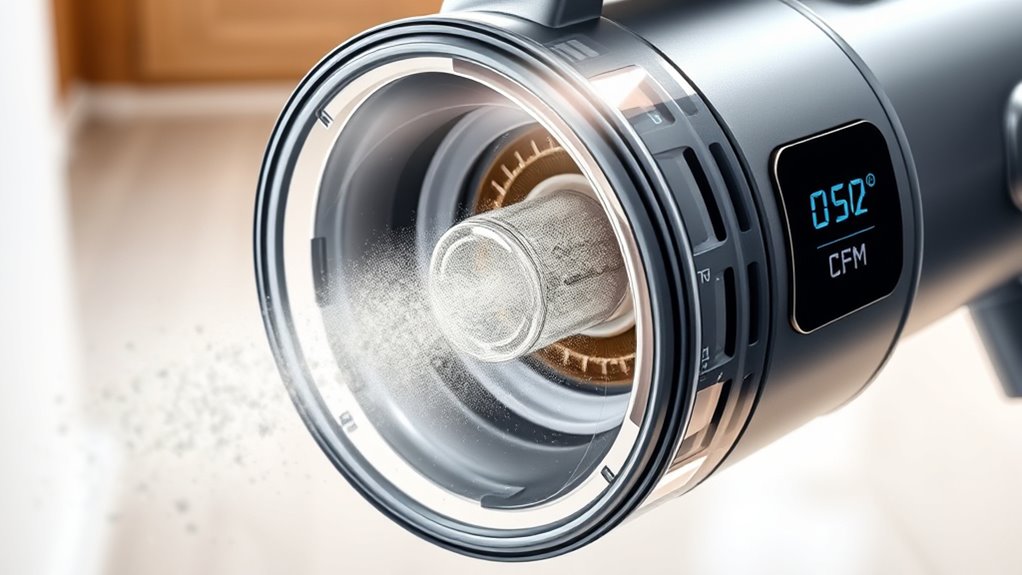
Have you ever wondered how the airflow capacity affects different vacuum cleaners? CFM plays a key role in determining each vacuum’s performance. Higher CFM usually means better airflow efficiency, making it easier to pick up dirt and debris. Different vacuums rely on CFM for specific tasks:
- Upright vacuums often have high CFM for deep cleaning carpets.
- Canister vacuums balance airflow for versatile use.
- Handheld models prioritize portability but still need adequate CFM.
- Robotic vacuums focus on maintaining efficiency with lower noise levels.
Understanding CFM helps you choose a vacuum that offers ideal airflow, enhancing cleaning power while reducing noise, especially in models designed for quiet operation.
Additionally, considering floor care features can further optimize your cleaning experience.
Practical Tips for Selecting a Vacuum With the Right CFM

Choosing the right vacuum with the appropriate CFM depends on your cleaning needs and the surfaces you plan to tackle. If you want powerful suction without excessive vacuum noise, look for models with a CFM that matches your tasks—higher for deep cleaning, lower for light jobs. Consider the cord length to make certain you can cover your space without frequent unplugging, especially if you have large areas. A longer cord paired with a suitable CFM helps you clean efficiently without sacrificing suction power. Also, think about storage space and ease of use; heavier vacuums with high CFM might be harder to maneuver. Ultimately, balancing CFM with features like cord length will help you select a vacuum that performs well and fits your lifestyle. Understanding airflow efficiency can further optimize your choice for different cleaning scenarios.
The Impact of CFM on Pet Hair and Deep Cleaning Tasks

Higher CFM improves suction power, making it easier to pick up pet hair and deep dirt. When your vacuum has the right airflow, cleaning becomes more efficient and less frustrating. Understanding how CFM affects these tasks helps you choose a model that keeps your home cleaner with less effort.
Suction Power Efficiency
Ever wondered how CFM influences a vacuum’s ability to pick up pet hair and handle deep cleaning tasks? Higher CFM improves airflow enhancement, which directly boosts suction efficiency. This means your vacuum can better lift stubborn debris and pet hair from carpets and upholstery. To maximize suction power, focus on these key factors:
- Consistent airflow without leaks
- Proper seal around attachments
- Adequate motor power for airflow generation
- Maintaining filters and hoses
When these elements work together, your vacuum becomes more effective at deep cleaning. A higher CFM ensures steady airflow, allowing for more thorough dirt and pet hair removal. Ultimately, excellent suction efficiency helps you clean more effectively and with less effort.
Pet Hair Removal Ease
A vacuum’s CFM directly impacts how easily it lifts pet hair from carpets and upholstery. Higher CFM means more airflow, helping to loosen and remove stubborn pet hair effectively. Good air filtration works with strong airflow to trap dander and allergens, making your home cleaner and healthier. An ergonomic design also plays a key role, allowing you to maneuver the vacuum comfortably around furniture and tight spaces, ensuring thorough pet hair removal. When CFM is optimized, your vacuum can better handle deep cleaning tasks, reducing the effort needed to keep your home pet-hair free. Keep in mind, a balance of airflow, filtration, and user-friendly design makes pet hair removal easier and more efficient, giving you a cleaner, fresher living space.
Deep Cleaning Effectiveness
CFM greatly influences a vacuum’s ability to perform deep cleaning tasks, especially when it comes to removing embedded pet hair and dirt from carpets and upholstery. Higher CFM means stronger airflow, which improves air filtration and guarantees debris is effectively lifted from deep within fibers. This results in cleaner carpets and better removal of stubborn dirt. Additionally, powerful airflow helps reduce dust and allergens, improving overall air quality. Keep in mind, though, that higher CFM often correlates with increased noise levels, so you might want to balance power with comfort. To maximize your vacuum’s deep cleaning effectiveness, consider these factors:
- High airflow for thorough dirt extraction
- Effective air filtration for healthier air
- Noise levels for comfortable use
- The ability to handle pet hair efficiently
Future Trends and Innovations in Vacuum Airflow Technology

Advancements in vacuum airflow technology are poised to transform how appliances deliver powerful and efficient cleaning. Future innovations will likely include smarter robot vacuums that optimize airflow for better suction and longer battery life. Enhanced air filtration systems integrated into these devices will improve indoor air quality by trapping more microscopic particles. Expect airflow controls that adapt dynamically to different surfaces and debris types, maximizing efficiency without sacrificing power. Manufacturers are also exploring quieter airflow mechanisms, making cleaning less disruptive. These innovations will enable vacuums to deliver stronger suction with less energy, while advanced air filtration ensures cleaner air circulation. As a result, your vacuum will become more effective, versatile, and healthier for indoor environments.
Frequently Asked Questions
How Does CFM Affect Vacuum Noise Levels?
Higher CFM in vacuums often increases the vacuum sound because more airflow creates louder noise. To reduce noise, look for models with noise reduction features or lower CFM ratings. You can also consider vacuums with sound-dampening technology, which helps minimize the noise levels during operation. So, managing CFM helps you balance cleaning power and comfort, making your vacuum quieter while still effective.
Can High CFM Damage Delicate Flooring or Surfaces?
Ever wonder if high CFM could harm your delicate surfaces? It generally won’t if you focus on floor protection and surface compatibility. High CFM just means more airflow, not necessarily more forceful suction that could damage your floors. As long as you use the right settings and attachments, you’ll keep your surfaces safe while enjoying efficient cleaning. Does your vacuum suit your specific flooring needs?
Is CFM More Important Than Motor Power?
You should know that CFM isn’t more important than motor power; instead, vacuum airflow plays a key role. A powerful motor with high efficiency improves airflow, helping you pick up dirt effectively without damaging delicate surfaces. While motor power provides strength, it’s the combination with good motor efficiency and airflow that ensures ideal cleaning without risking surface damage. Focus on both aspects for the best vacuum performance.
How Does CFM Influence Vacuum Weight and Portability?
Think of CFM as the heartbeat of your vacuum’s airflow—it directly impacts its weight and portability. Higher CFM models often pack more power but tend to be heavier, making vacuum portability a challenge. Conversely, lower CFM units are lighter and easier to maneuver, perfect for quick cleanups. When choosing, consider weight considerations carefully—you want a vacuum that’s powerful enough but still easy to carry through your home.
Are There Specific CFM Ranges for Allergy-Friendly Vacuums?
If you’re aiming for an allergy-friendly vacuum, look for models with a CFM between 60 and 100. This range guarantees better air quality and air circulation by effectively removing allergens and dust particles from your home. Higher CFM values help trap more debris, reducing airborne allergens. Keep in mind, though, that a balance is key—too high CFM might impact your vacuum’s portability and energy use.
Conclusion
Understanding CFM helps you choose the right vacuum, improves your cleaning, and tackles pet hair and deep messes effectively. By prioritizing airflow, evaluating performance, and avoiding myths, you make smarter decisions. Remember, CFM influences efficiency, power, and results. Focus on airflow, compare CFM ratings, and select a vacuum that meets your cleaning needs. With the right knowledge, you’ll clean better, faster, and more confidently—because airflow matters, performance counts, and your home deserves the best.
